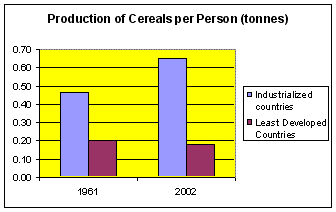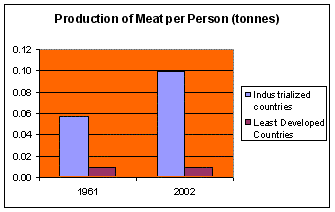Food
History of food production
The domestication of animals and plants for agriculture began in the Middle East about 10,000 years ago and spread north throughout Europe. Until then, humans survived from hunting and gathering. Production increased with the transition from simple manual tools to animal-powered tools and finally with the industrial revolution to motorised tools.

Figure 2 (Source: FAO database)
FAO statistics show that industrialised countries have much higher productivity in cereal crops: there are three times more cereal crops per head of population than in the poorest or least developed countries. The figures also show that the amount per person has fallen in the poorest countries. (see Figure 2):
It is the same situation with meat. (see Figure 3):
In the 1980’s over-production in Europe resulted in the infamous ‘wine lakes’ and ‘butter mountains’. This was a direct consequence of the European Union’s Common Agricultural Policy subsidies, which increased with the amount of food produced.

Figure 3 (Source: FAO database)
By 1988, the Common Agricultural Policy had absorbed nearly 70% of the EU budget. Today it represents about 40% and the Policy now makes grants to supplement farm incomes rather than making subsidies based on the amount produced. Although the amount of money involved has declined over the last decade the EU continues to subsidize its farmers. In fact, expenditure may well go up again with the expanded membership of the EU from 15 countries to 25.







